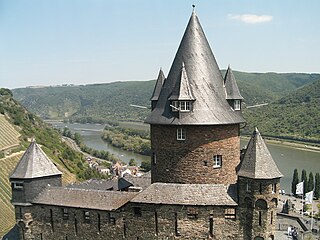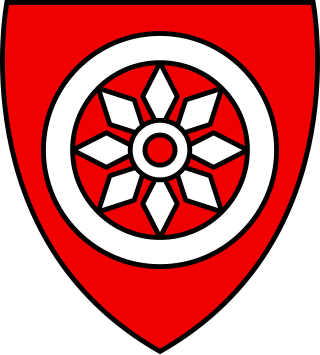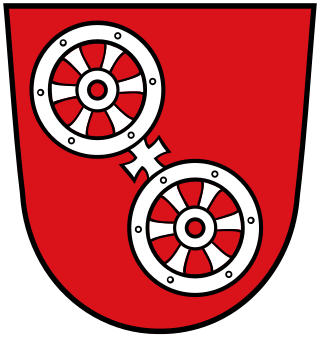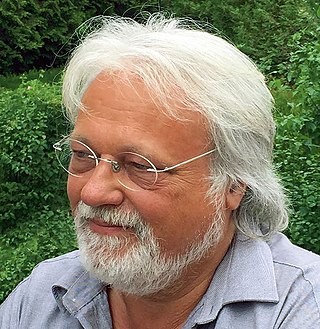
Mainz, previously known in English as Mentz or Mayence, is the capital and largest city of Rhineland-Palatinate, Germany.

Rhineland-Palatinate is a western state of Germany. It covers 19,846 km2 (7,663 sq mi) and has about 4.05 million residents. It is the ninth largest and sixth most populous of the sixteen states. Mainz is the capital and largest city. Other cities are Ludwigshafen am Rhein, Koblenz, Trier, Kaiserslautern, Worms and Neuwied. It is bordered by North Rhine-Westphalia, Saarland, Baden-Württemberg and Hesse and by France, Luxembourg and Belgium.

The Rhineland-Palatinate Landtag is the state diet of the German federal state of Rhineland-Palatinate.

Stahleck Castle is a 12th-century fortified castle in the Upper Middle Rhine Valley at Bacharach in Rhineland-Palatinate, Germany. It stands on a crag approximately 160 metres (520 ft) above sea level on the left bank of the river at the mouth of the Steeg valley, approximately 50 kilometres (31 mi) south of Koblenz, and offers a commanding view of the Lorelei valley. Its name means "impregnable castle on a crag", from the Middle High German words stahel (steel) and ecke. It has a water-filled partial moat, a rarity in Germany. Built on the orders of the Archbishop of Cologne, it was destroyed in the late 17th century but rebuilt in the 20th and is now a hostel.

The Zeughaus is a listed building and the oldest structure on Unter den Linden boulevard in the historic centre of Berlin. Erected from 1695 to 1706 according to plans by Johann Arnold Nering, Martin Grünberg, Andreas Schlüter and Jean de Bodt in Baroque style, it was later converted into a Prussian Hall of Fame. Damaged during the Allied bombing in World War II, it was rebuilt from 1949 to 1967 as part of the Forum Fridericianum. Since 2003, it has been home to the Deutsches Historisches Museum. Since June 2021 it is closed for necessary renovations and for the renewal of the Permanent Exhibition probably until the end of 2025.

Rheinböllen is a town in the Rhein-Hunsrück-Kreis (district) in Rhineland-Palatinate, Germany. It belongs to the Verbandsgemeinde Simmern-Rheinböllen, whose seat is in Simmern. It was the seat of the former Verbandsgemeinde Rheinböllen.

The Elector of Mainz was one of the seven Prince-electors of the Holy Roman Empire. As both the Archbishop of Mainz and the ruling prince of the Electorate of Mainz, the Elector of Mainz held a powerful position during the Middle Ages. The Archbishop-Elector was president of the electoral college, archchancellor of the empire, and the Primate of Germany as the papal legate north of the Alps, until the dissolution of the empire in 1806.

Mainz Hauptbahnhof is a railway station for the city of Mainz in the German state of Rhineland-Palatinate. It is used by about 60,000 travelers and visitors each day and is therefore by far the busiest station in Rhineland-Palatinate. The station was a trial area for a CCTV scheme using automated face recognition.

The Deutschhaus or Deutschordenskommende is a historical building in Mainz, western Germany, which is the seat of the Rhineland-Palatinate Landtag.
Johann Maximilian von Welsch was a German architect, construction director and fortress master builder.

The Wheel of Mainz or Mainzer Rad, in German, was the coat of arms of the Archbishopric of Mainz and thus also of the Electorate of Mainz (Kurmainz), in Rhineland-Palatinate, Germany. It consists of a silver wheel with six spokes on a red background. The wheel can also be found in stonemasons' carvings and similar objects. Currently, the City of Mainz uses a double wheel connected by a silver cross.

Neef is an Ortsgemeinde – a municipality belonging to a Verbandsgemeinde, a kind of collective municipality—in the Cochem-Zell district in Rhineland-Palatinate, Germany. It belongs to the Verbandsgemeinde of Zell, whose seat is in the municipality of Zell an der Mosel. Neef is a winegrowing centre.

Dichtelbach is an Ortsgemeinde – a municipality belonging to a Verbandsgemeinde, a kind of collective municipality – in the Rhein-Hunsrück-Kreis (district) in Rhineland-Palatinate, Germany. It belongs to the Verbandsgemeinde Simmern-Rheinböllen, whose seat is in Simmern.

Klosterkumbd is an Ortsgemeinde – a municipality belonging to a Verbandsgemeinde, a kind of collective municipality – in the Rhein-Hunsrück-Kreis (district) in Rhineland-Palatinate, Germany. It belongs to the Verbandsgemeinde Simmern-Rheinböllen, whose seat is in Simmern.

The Landesmuseum Mainz, or Mainz State Museum, is a museum of art and history in Mainz, Germany. In March 2010 it reopened in full after an extensive renovation.

Johann Adam von Bicken was the Archbishop-Elector of Mainz from 1601 to 1604.

Johann Schweikhard von Kronberg was the Archbishop-Elector of Mainz from 1604 to 1626.
The following is a timeline of the history of Koblenz, Germany.
The following is a timeline of the history of the city of Mainz, Germany.

Michael Post is a German painter, Object artist and curator. He is an exponent of concrete art.

















